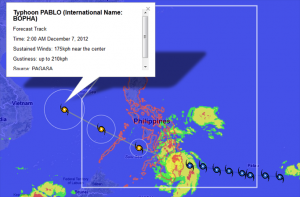MANILA, Philippines – Two people were killed in the aftermath of typhoon Pablo (international name Bopha) which smashed into southern Philippines early Tuesday and sent more than 40,000 people cramming into shelters to escape the onslaught of the strongest cyclone to hit the country this year.
Erlinda Balante, 60, of Manay, Davao Oriental, died after reportedly being hit by a fallen tree Tuesday morning. The second fatality, Roger Gumunit, 30, was killed when he was also hit by a tree while aboard a motorcycle, in Panaon, Misamis Oriental, authorities said.
At 4:00 a.m. Tuesday, Pablo’s center was estimated based on satellite and surface data at 40 kilometers east of the eastern coast of Davao Oriental, raking across the island of 10 million people, packing maximum sustained winds of 175 kilometers per hour and gusts of up to 210 (130 miles) kph and bringing heavy rain, the Philippine Atmospheric Geophysical and Astronomical Services Administration (Pagasa) said.
The typhoon was forecast to move west-northwest at 26 kph, Pagasa added.
Public Storm Warning Signal No. 3 was raised over Southern Leyte, Bohol, Negros Oriental, Siquijor, Southern Cebu, Surigao del Norte incl. Siargao, Surigao del Sur, Dinagat Province, Agusan del Norte, Agusan del Sur, Misamis Oriental, Camiguin, Bukidnon, Davao Oriental, Compostela Valley, North Cotabato, Lanao del Sur, Lanao del Norte Misamis Occidental, Zamboanga del Norte, Zamboanga del Sur and Davao del Norte incl. Samal Is.
Signal No. 2 was raised in Iloilo, Guimaras, Capiz, Leyte incl. Biliran, Negros Occidental, rest of Cebu including Camotes Is., Davao del Sur, Sultan Kudarat, Zamboanga Sibugay and Maguindanao.
Meanwhile, Palawan including the Calamian Group of Islands, Ticao Island, Masbate, Northern Samar, Eastern Samar, Western Samar, Aklan, Antique, Basilan, Sarangani and South Cotabato were placed under Signal No. 1.
Pagasa warned residents living in low lying and mountainous areas under public storm warning signals against possible flashfloods and landslides.
Likewise, those living in coastal areas under Signal No. 2 and Signal No. 3 are alerted of possible storm surges particularly those living in the coastal areas of Surigao del Sur, Surigao del Norte, Dinagat, Bohol and Leyte provinces where 3-6 meters wave height is expected.
The weather bureau advised fishing boats and other sea vessels not to venture out into the eastern seaboards of Visayas and Mindanao.
According to Pagasa, Typhoon Pablo is expected to be at 180 km southwest of Roxas City by Wednesday morning. By Thursday morning, it will be at 230 km northwest of Puerto Princesa City and 780 km west of Metro Manila by Friday morning.
Aviation and shipping were suspended, with 80 flights grounded and thousands of ferry passengers stranded at ports as the coastguard ordered vessels to stay in port, the civil defence office said.
More than 41,000 people had moved into nearly 1,000 government shelters across the island by early Tuesday, it said in its latest bulletin.
The commercial centre of Cagayan de Oro, one of Mindanao’s largest cities, was hit by flooding as rivers overflowed following heavy rain.
School holidays were declared in Mindanao and large areas of the central Philippines.
President Benigno Aquino III led calls for evacuations on Monday, saying: “(Bopha’s) destructive potential is no laughing matter. It is expected to be the strongest typhoon to hit our country in 2012.”
The Philippines is battered by about 20 typhoons a year, some of them destructive. Bopha is the sixteenth so far this year.
In August, nearly 100 people were killed and more than a million were displaced by heavy flooding caused by a series of storms.
Nineteen typhoons struck the country last year, of which 10 were destructive, leading to more than 1,500 deaths and affecting nearly 10 percent of the total population, according to the government.
